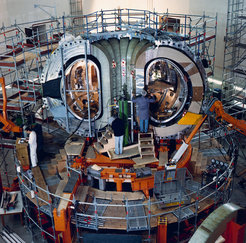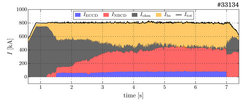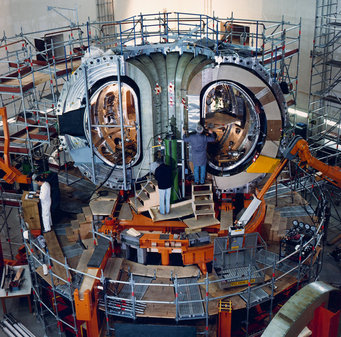Continuous operation of tokamaks getting closer
Promising experiments on ASDEX Upgrade / Conditions for ITER and DEMO almost attained
Fusion devices of the tokamak type, which in principle operate in pulsed mode, are heading for continuous operation. In his PhD thesis Alexander Bock, a scientist at Max Planck Institute for Plasma Physics (IPP) in Garching bei München, investigated how to sustain the magnet cage for the plasma differently from hitherto, making it suitable for continuous operation. Successfully: Special discharges achieved in the ASDEX Upgrade fusion device allowed the 800-kiloampere electric current to be externally driven – under conditions also applicable to the ITER test reactor or a demonstration power plant.

The objective of fusion research is to develop a power plant favourable to the climate and environment. As in the sun, it is to derive energy from fusion of atomic nuclei. Since the fusion fire does not ignite till temperatures of over 100 million degrees, the fuel, a low-density hydrogen plasma, ought not to come into contact with cold vessel walls. Confined by magnetic fields, the fuel hovers virtually without contact inside a ring-shaped vacuum chamber.
To make the magnetic cage stable and tight, the field lines have to run around inside the circular chamber as large nested helices. They thus form closed, nested surfaces, just like those of the annual rings of a tree trunk. On these magnetic surfaces, on which the plasma particles move, the mean field line twisting as well as density and temperature each remain constant, whereas from surface to surface – from the hot core outwards – the twisting of the field lines and also the density, temperature and plasma pressure decrease.
Fusion devices of the tokamak type, such as ASDEX Upgrade at Garching or the ITER international test reactor, now being built at Cadarache in France, use two superimposed magnetic fields to form the magnet cage: fist a ring-shaped field generated by external planar coils, and secondly the field of a current flowing in the plasma. In the combined field the field lines then run around helically and form the magnetic surfaces.
The plasma current is normally induced in pulsed mode by a transformer coil in the plasma. The entire device therefore does not operate continuously but in pulses, this being a shortcoming of the otherwise so successful tokamaks, states IPP scientist Alexander Bock. “For example, the ever changing load could curtail the power plant’s lifetime.” Besides this, the current makes the plasma susceptible to various instabilities that can perturb the plasma confinement. With devices of the stellarator type it is quite a different matter. Wendelstein 7-X, the world’s largest of this type, was recently put into operation at the Greifswald branch of IPP. As the entire field can be generated here solely by complexly shaped coils, i.e. without plasma current, it is thus possible to have continuous operation.

It has therefore long been attempted to achieve continuous operation in a tokamak as well, i.e. the current in the plasma is produced not pulsewise by means of a transformer, but continuously, e.g. by injecting high-frequency waves or particle beams. In his PhD thesis Alexander Bock investigated what effects can be achieved in this way. The great advantage with a current externally driven, at least partially, is that the “usual” profile of the current in the plasma can be influenced and the twisting of the field lines be tailored as required. If, for example, the plasma current is decreased at the core, the twisting of the field lines is decreased there. By way of complex relationships between the collective particle motions this fortifies the so-called bootstrap current at the plasma edge. This electric current, which the plasma can produce on its own in the presence of pressure differences, can account for a few ten per cent of the total current. It can therefore be used to make the discharges more independent of the transformer and achieve longer pulses – if some subsidiary conditions can be satisfied so that the quasi self-confining plasma stays in stable equilibrium. “In the best case”, states Alexander Bock, “such an Advanced Tokamak could be operated in steady state.” Furthermore, a flatter twisting profile should also prevent turbulences in the plasma and hence improve confinement.
This has actually been achieved by the ASDEX Upgrade team by exact control of discharges – unlike in previous experiments on the Garching device, but also on DIII-D in the USA, the European JET device and Japan’s JT-60U – for the first time in a machine with an all-metal inside wall. For since 2007 the wall of ASDEX Upgrade’s plasma vessel has been entirely clad with tungsten, the metal with the highest melting point. Under these challenging, but reactor-relevant conditions operation almost without transformer has now been achieved, while affording stable plasma, high plasma pressure and good confinement properties in a parameter range in which future power plants are to be working. Microwaves and particle beams injected close to the plasma core notably prolonged the plasma pulse: The 800-kiloampere plasma current remained constant for three seconds even without a transformer. The bootstrap current accounted for half the total current here. If the device had not been equipped with normal-conducting copper coils, but with superconducting coils as envisaged for ITER, this phase could have been extended much longer – potentially up to steady state. Alexander Bock’s conclusion: “The discharges show that attractive operation without transformer is possible in ASDEX Upgrade. It is therefore worthwhile to continue the Advanced Tokamak studies.”
Isabella Milch

